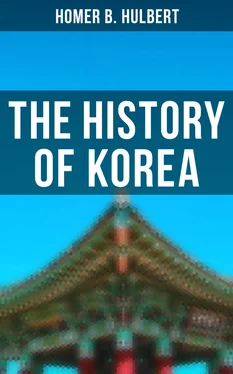In 417 Nul-ji came to the throne of Sil-la and began a reign that was to last well on toward half a century. He was a regicide. He had been treated very harshly by the king and had more than once narrowly escaped with his life. It is therefore the less surprising, though none the less reprehensible, that when the opportunity presented of paying off old scores he succumbed to the temptation. He ascended the throne not with the title of I-sa-geum, which had been the royal title for centuries, but with the new title of Ma-rip-kan. However doubtful may have been his title to the crown his reign was a strong one. Among the far-reaching effects of his reign the introduction of carts to be drawn by oxen was the most important.
The friendly relations of Ko-gu-ryŭ with the Tsin dynasty were cut short by the extinction of that dynasty in 419 but in 435 Ko-gu-ryŭ made friendly advances toward the Northern Wei dynasty and, finding sufficient encouragement, she transferred her allegience to that power. Meantime Păk-je had transferred hers to the Sung dynasty which arose in 420.
It was in 436 that P’ung-hong, the “Emperor” of Yun, found himself so weak that he could not withstand the pressure from the Chinese side and asked the king of Ko-gu-ryŭ to grant him asylum. Consent was given and an escort was sent to conduct him to the Ko-gu-ryŭ capital. He found that this sort of life had its drawbacks; for, to begin with, the king did not address him as emperor but simply as king. This was a great affront to his dignity and, though he was treated very handsomely, he assumed such a supercillious bearing that the king had to curtail his retinue and his income. He had been given quarters in Puk-p’ung and from there the mendicant emperor applied to the Sung Emperor for asylum. It was granted, and seven thousand soldiers came to escort him; but ere they arrived the king of Ko-gu-ryŭ sent two generals, Son-su and Ko-gu, who killed the imperial refugee and nine of his attendants. The Sung troops, arriving on the instant, discovered the crime and caught and executed the two generals who had perpetrated it.
In 449 a Ko-gu-ryŭ general was out on a hunting expedition and the chase brought him into Sil-la territory near the present town of Kang-neung. The prefect of the district, in an excess of patriotic enthusiasm, seized him and put him to death. An envoy came in haste to the Sil-la capital demanding why this outrage had been committed. War would have been declared on the spot had not Sil-la been profuse in apologies. She might have spared herself this humiliation for war was sure to break out soon in any case. When ngcame to the throne of Păk-je in 455, Ko-gu-ryŭ took advantage of the confusion, consequent upon the change, to attack her. Sil-la, who, though ordinarily a peaceful power, had been perforce drawn into war-like operations and had acquired some military skill, now sided with Păk-je. Sending a considerable number of troops she reinforced Păk-je to the extent of warding off the threatened invasion. But Păk-je, though glad to find herself extricated from her position of danger, would allow no feelings of gratitude to stand in the way of her ancient feud against Sil-la; so this act of friendship not only did not help toward peace but on the contrary, by showing Sil-la the fickleness of Păk-je, made peace all the more impossible. The middle of the fifth century marks the point when all friendly relations between the three Korean states were broken off and an actual state of war existed between them from this time on, though active military operations were not constant. This we may call the Triangular War.
The key to this great struggle, which resulted in the advancement of Sil-la to the control of the whole peninsula, lay not so much in the relative military strength of the three rival kingdoms as in the skill which each developed in diplomacy. Each was trying to gain the active support of China, knowing very well that if China should once become thoroughly interested in favor of any one of the three powers the other two would be doomed.
We will remember that Ko-gu-ryŭ had cultivated friendlyrelations with the Sung dynasty while Păk-je had made herself agreeable to the Wei dynasty. In this Păk-je chose the wiser part for the Wei power was nearer and more powerful. In 466 Ko-gu-ryŭ lost a splendid opportunity to establish herself in the good graces of the Wei Emperor, and so insure her preeminence in the peninsula. The Emperor Hsien-wen made friendly advances and requested the daughter of the king of Ko-gu-ryŭ for his wife. With a short-sightedness that is quite inexplicable this request was put off by the lame excuse that his daughter was dead. This being easily proved a falsehood, Ko-gu-ryŭ fell from the good graces of the very power whose friendship she should have cultivated.
The year 467 witnessed an important innovation in Korea. Sil-la took the lead in the construction of war vessels. The one made at that time was doubtless intended for use against the Japanese corsairs. That Sil-la had been gaining along military lines is shown by her successful repulse of a Ko-gu-ryŭ invasion in this year, in which the wild people of some of the Mal-gal tribes assisted Ko-gu-ryŭ. After the latter had been driven back, Sil-la built a fortress at Po-eun on her northern border to guard against a repetition of this invasion.
Ko-gu-ryŭ and Păk-je were now exerting themselves to the utmost to make capital out of their Chinese alliances. Ko-gu-ryŭ sent rich presents and richer words to the Sung capital and so won the confidence of that power. Păk-je, on the other hand, sent word to the Wei Emperor that Ko-gu-ryŭ was coquetting with the Sung court and with the wild Mal-gal tribes, insinuating that this was all detrimental to the interests of Păk-je’s patron.
As this was without result, she sent and asked openly that the Wei Emperor send anarmy and chastise Ko-gu-ryŭ. The Emperor replied that until Ko-gu-ryŭ committed some overt act of more hostile import than the mere cementing of peaceful alliances no notice could be taken of her. In other words the Wei power refused to be the aggressor, much to Păk-je’s chagrin. The Wei Emperor sent this answer by way of Ko-gu-ryŭ and the king of that country was ordered to grant the messenger a safe conduct through his territory. But Ko-gu-ryŭ, as though bent on self-destruction, refused to let him pass, and so the great northern kingdom approached one step nearer the precipice which was to prove her destruction. Upon learning the news of this affront the Emperor was highly incensed and tried to send the messenger by way of a southern port; but stress of weather rendered this impossible and Păk-je, receiving no answer to her missive, took offense and would have nothing more to do with China, for a time. By the time she had recovered her temper, Ko-gu-ryŭ had in some way patched up her difficulty with the Wei court and so scored a point against Păk-je. And for a time she was on friendly terms with both the Wei and Sung dynasties.
At this point Ko-gu-ryŭ decided upon a bold attempt to swallow Păk-je bodily. It was to be done partly by strategem and partly by force. A monk of Ko-gu-ryŭ named To-rim, a fellow of excellent craft, arrived at the Păk-je capital as if seeking refuge. The king received him with open arms and, finding him an excellent chess player, made him his trusty councilor. This monk told the king that the palaces, walls, tombs and public buildings ought to be thoroughly repaired, and so induced him to drain the public treasury in this work, and also in bringing a huge monolith from Uk-nyi to the capital. This done the monk fled back to Ko-gu-ryŭ and announced that the treasury of Păk-je was empty and it was a good time to attack her. A large army was put in the field, guided by one Kŭl-lu, a Păk-je fugitive from justice. Almost before Păk-je was aware, her capital was surrounded. She had applied to Sil-la for help, but too late. First the suburbs were laid in ashes, and then access being gained, the palace was fired. The king fled with ten attendants out the west gate, but Kŭl-lu the renegade followed and overtook him. The king begged for mercy upon his knees but Kŭl-lu spit thrice in his face, bound him and sent him to the fortress of A-han where lie was killed. Then the Ko-gu-ryŭ army went back north carrying with them 8,000 captives, men and women.
Читать дальше









